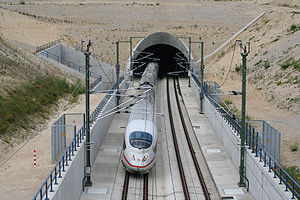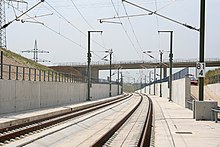Geisberg tunnel
|
Geisberg tunnel Geisberg tunnel / Geißberg tunnel
|
||
|---|---|---|
|
An ICE 3 leaves the south portal
|
||
| use | Railway tunnel | |
| traffic connection | New Nuremberg – Ingolstadt line | |
| length | 3289 m | |
| Number of tubes | 1 | |
| construction | ||
| Client | DB network | |
| start of building | 1999 | |
| completion | December 2003 (shell) | |
| business | ||
| operator | DB network | |
| release | 2006 | |
| location | ||
|
|
||
| Coordinates | ||
| North portal | 48 ° 50 ′ 35 " N , 11 ° 27 ′ 35" E | |
| South portal | 48 ° 49 ′ 11 " N , 11 ° 26 ′ 1" E | |

The Geisberg Tunnel (also Geisberg Tunnel or Geißberg Tunnel , formerly also Neuhautunnel ) is a railway tunnel on the high-speed line from Nuremberg to Ingolstadt . With a length of 3289 m (route km 78.085 to 81.374) it is the third longest of the nine tunnels on the route. The single-tube tunnel accommodates two tracks in slab track , which can be driven on as planned at 300 km / h.
A trough structure from km 81.8 is in front of the south portal. The Stammham tunnel is 750 meters from the northern end of the tunnel .
course
The route of the new line runs in a tunnel under the training area Hepberg on the districts of the communities (from north to south) Stammham , Hepberg and Wettstetten ; State road 2335 runs south of the facility. From this the Etting bypass branches off , which runs parallel to the new line to the west until the curve leading into the Auditunnel. The southern pre-cut lies in the transition from the Franconian Alb to the Ingolstadt basin .
The gradient of the route falls in the direction of Ingolstadt in the northern third of the tunnel with 20.0 per mille. This value is reached over a length of 1815 m from km 77.775 to 79.590, in the northern half. This is the longest of the nine 20 per mil sections of the route. In the middle third, the gradient drops to 5.0 per mil. In front of the south portal, the gradient increases to 11.657 per thousand.
history
planning
According to the planning status from mid-1989, the 324 m long Neuhaut Tunnel was planned in this area to cross under the Bundeswehr training area.
In the further course of the procedure, the tunnel was extended in both directions and thus crossed the municipality of Hepberg completely underground.
The municipal council of Wettstetten advocated the new line between Nuremberg and Ingolstadt as part of the regional planning procedure in November 1989, but called for the 500 m long tunnel to be extended by around 200 m to the south.
In mid-1994 the planned length was 3289 m. The drive should be carried out from both portals.
The tunnel was part of the planning approval section 71 of the new line and was located in its southern construction lot .
construction
Most of the tube (3,019 m) was built using shotcrete . At the north portal, 20 blocks (270 m) of the tube were constructed using the cut-and-cover method.
The contract was awarded to a consortium in September 1998 . Construction began at the beginning of 1999. With the attack, tunneling began in the north on June 29, 1999, and in the south on August 13 of the same year. The breakthrough took place on August 29, 2000. From mid-February 2002, the inner shell was erected from the south portal.
Heavy karstification led to a delay of around 30 months, so that the shell could not be completed until December 2003.
The tunnel was part of the southern construction lot of the new line, which was commissioned by a consortium of Walter Bau ( Augsburg ) under the leadership of Dywidag .
security concept
The tunnel has a total of four emergency exits :
- The emergency exits 1a and 1b lead out of the tunnel, 1000 m and 1200 m respectively from the north portal. After a 105 m long parallel gallery running west of the tunnel, a shaft 40 m high and 8.0 m in diameter leading to the surface is reached.
- The emergency exits 2a and 2b are 1094 m and 994 m away from the south portal. A shaft with a diameter of 5.8 m and a height of 24 m is reached via an accessible tunnel 150 m (2a) or 144 m (2b) in length.
In the two rescue shafts, spiral stairs lead to the surface. The higher of the two shafts was also equipped with an elevator. The safety lighting is normally switched off.
On April 8, 2006, a rescue exercise for the fire brigades affected in an emergency took place in the Geisberg tunnel . The technical relief organization, the Maltese relief service and the Red Cross were also involved in the exercise.
See also: Safety concept for the new line
Web links
- Geisberg tunnel. In: Structurae
- Practice-oriented treatment of karst problems using the example of rock cuts in the southern construction lot (pdf, 8.38 MB)
- Basic concept for solving the karst and sinkhole problems for the construction of traffic routes (pdf, 2.56 MB)
Individual evidence
- ↑ a b Residents stay on the opposite course . In: Ingolstädter Zeitung , ZDB -ID 1477609-1 , July 28, 1989.
- ↑ Judgment of the Bavarian Administrative Court of January 10, 1997, file number 20 A 96.40052, 20 A 96.40068, 20 A 96.40073 and decision 20 AS 96.40069, 20 AS 96.40074; joint version as PDF file (56 pages) from the library of the Bavarian Administrative Court, Ansbach; P. 4.
- ↑ a b c Günter Strappler, Heinz-Dieter Könnings: New line Nuremberg - Ingolstadt sticking points in the handling of tunnel projects . In: Rock Engineering , ISSN 0174-6979 , Vol 17 (1999), No. 5, pp 358-366...
- ↑ a b Weigelt (2006), p. 109 f., 120.
- ↑ ICE and local transport keep the discussion going . In: Donaukurier , regional edition Ingolstadt, October 7, 1989.
- ↑ “Basically yes” to the ICE route . In: Donaukurier , November 9, 1989.
- ^ Deutsche Bahn, Network Division, Regional Area Nuremberg (ed.): New Nuremberg – Ingolstadt line . 12-page brochure dated July 1994, pp. 6, 10.
- ^ New ICE and upgraded Nuremberg - Munich line - status of construction work in June 2005 Information sheet from DB ProjektBau, Nuremberg.
- ^ Planungsgesellschaft Bahnbau Deutsche Einheit mbH (Ed.): Nuremberg – Munich in one hour . Nuremberg, November 30, 1999 (similar version from January 1999 as PDF file , 2.3 MB), p. 9.



